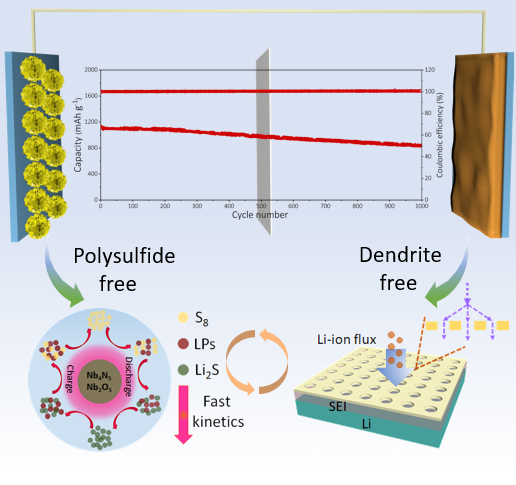Novel Heterostructure Nanosheet Boosts Efficiency of Lean‐electrolyte Li-S Batteries
The lithium sulfur (Li-S) battery is promising for next‐generation energy storage technologies. However, lithium polysulfide shuttling, sluggish redox kinetics, and uncontrollable lithium dendrite growth limit the cycling stability.
A research group led by Prof.WU Zhongshuai from the Dalian Institute of Chemical Physics (DICP) of the Chinese Academy of Sciences, developed niobium (V)‐based heterostructure nanosheet for polysulfides‐suppressed sulfur cathodes and dendrite‐free lithium anodes in long‐cycling and lean‐electrolyte Li-S battery.
This study was published in Advanced Functional Materials on April 28.

Schematic of bifunctional niobium (V)‐based heterostructure nanosheet toward high efficiency lean‐electrolyte lithium–sulfur full batteries (Image by SHI Haodong)
"We developed a twinborn holey Nb4N5-Nb2O5 heterostructure, serving as dual‐functional host for both redox-kinetics-accelerated sulfur cathode and dendrite‐inhibited lithium anode simultaneously," said Prof. WU.
Polysulfide‐shutting was alleviated due to the accelerative polysulfides anchoring-diffusion-converting efficiency of Nb4N5-Nb2O5. Meanwhile, the researchers applied lithiophilic nature of holey Nb4N5-Nb2O5 as an ion‐redistributor for homogeneous Li‐ion deposition.
The Li-S full battery presented a high areal capacity of 5.0 mAh cm-2 at sulfur loading of 6.9 mg cm-2, corresponding to negative to positive capacity ratio of 2.4:1 and electrolyte to sulfur ratio of 5.1 μL mg-1.
This work paves a new avenue for boosting high‐performances Li-S batteries toward practical applications.
This work was support by National Key R&D Program of China and Dalian National Laboratory For Clean Energy. (Text by SHI Haodong and HOU Xiaocheng)